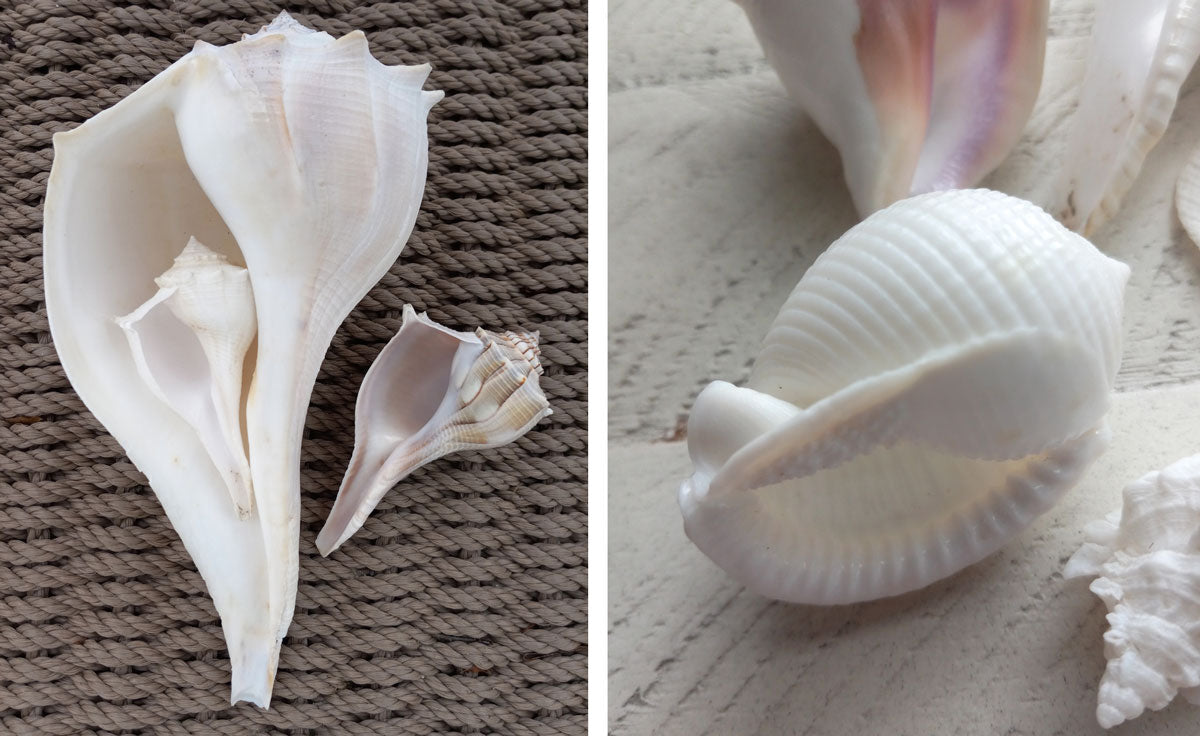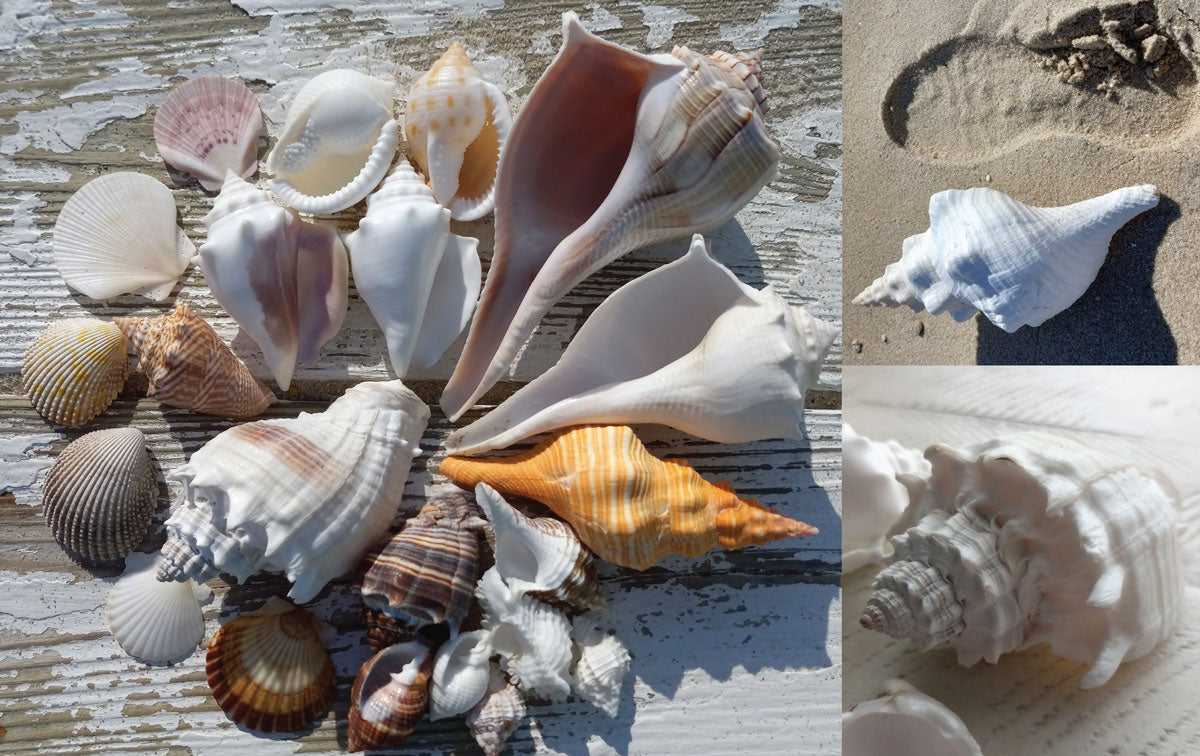Albino Seashells: Whiteout on the Beach
By Rodie Kaiser

Very little is known about the evolution of color in mollusks. More is known about mollusks that have no color. There is nothing more mystical than viewing an iridescent albino seashell that glows like a prism. When I started shell collecting, my knowledge of albinism came only from my childhood pet guinea pig and rabbit.
Albinism is a genetic mutation of tyrosine which is the enzyme responsible for manufacturing melanin (pigment). Even when the mollusk is not albino, its shell can be albino due to a cell mutation in its mantle, the layer of flesh covering the head, foot, and body that secretes the shell. Other causes of albinism include differences in diet, changes in habitat, injury, and aging. A mollusk’s injured soft tissue can turn both its body and shell white, and female lightning whelks turn white as they age.
Albino shells are also mistaken for solid white and exceptionally blonde shells. Albino shells are translucent and true albino shells glow—just like I do when I find them! Since I never have hunted for them, my albino shells were all unexpected finds, primarily collected from Southwest Florida’s Ten Thousand Islands.

I collected an empty albino lightning whelk shell from the mud flats in Tampa Bay that is over a foot long. It was heartbreaking to find a deceased, magnificent albino lightning whelk deposited after a traumatic storm event that blew the screens out of my lanai. I loved its enormous size and brilliance, and eventually loaned it to my mom who loves white shells. A few years ago, I realized it’s an albino shell! Mom found other albino shells from Sanibel Island, including a remarkable Scotch bonnet from Bowman’s Beach.
I booked a shelling tour with a friend to Kice Island on a sweltering, late spring day. As soon as we landed, we jumped out of the skiff and sprang into action. My radar immediately kicked in, telling me to head to the right.

I turned and walked a few steps, only to be blinded by a bright-white Florida fighting conch, gleaming in the early morning sun. I rolled it over to check if it was empty, and it glowed purple with gold lamé tints. I immediately ran to my friend in excitement, “I got my haul!”

After moving to Goodland, Florida, I began shell collecting daily on Marco Island, Florida. The beaches were always empty except for one, which I realized was an albino shell super highway. There were albino fighting conchs, ribbed cantharus shells, prickly cockles, and a snow-white alphabet cone with scant letters sitting in a tidal pool. My albino shell collection ignited like wildfire. Along the high wrack line, entangled in seaweed, I found a bright albino apple murex next to a chocolate-colored mate.
After a stormy day on North Collier, I made an unexpected stop at Residents’ Beach parking lot due to habit. I went shelling on a whim, walking to the shoreline as evil-looking storm clouds approached. The Gulf was raging, but I got into the water waist deep and grabbed something dark, pulling out a beautiful juvenile albino Florida horse conch with its periostracum (the organic coating on some shells that protects the organism from corrosion) still intact. As I unlocked the front door, the storm clouds broke, and I was home safe with my newest member of the “A Club.” I have had similar experiences, finding a large horse conch near Tigertail Beach in Marco Island and a lace murex that transformed white with bleaching.

On another beach trek, I picked up what appeared to be an old grey “flat” scallop, the top valve of a Ravenel’s scallop. I let it drop back on the beach, and continued to walk, then stopped in my tracks. A voice told me to turn back and retrieve it. I did and threw it in mild bleach with the rest of the haul then into a basket when I got home. A week later, I emptied the basket looking for the grey flat scallop. Poof! It was gone, and in its place, there was an albino flat scallop.
My job at a marina in Goodland allowed me time at lunch to venture to the shore to watch for roseate spoonbill birds and their offspring. One day, I spotted two white lightning whelks in the water, and I assumed they were alive, so I let them be. When I ventured back to the spot, one had disappeared and the other was caught in the mangrove roots. When I went to rescue the trapped whelk, I realized it was a deceased albino whelk. Another one for the club!
I convinced myself that cold water albinos must not exist. Was I wrong! I recently shelled at Cape Cod’s Nantucket Sound in southeastern Massachusetts after a high wind event, there was an albino North Atlantic Bay Scallop waiting to join the club. The following week, I found another albino pair just 20 feet away.
My endless love for shelling and my fondness for mollusks—especially the sought-after albino shells—continues to explode.
Learn more about seashells
Learn more about identifying shells, the history of seashell collecting, great shelling beaches, and the lives of the animals who make the shells we find on the beach. Articles ›
No live shelling: Be sure shells are empty and sand dollars, sea stars, and sea urchins are no longer alive before you bring them home.
All photos by Rodie Kaiser.
This article appeared in the Beachcombing Volume 37: July/August 2023.







